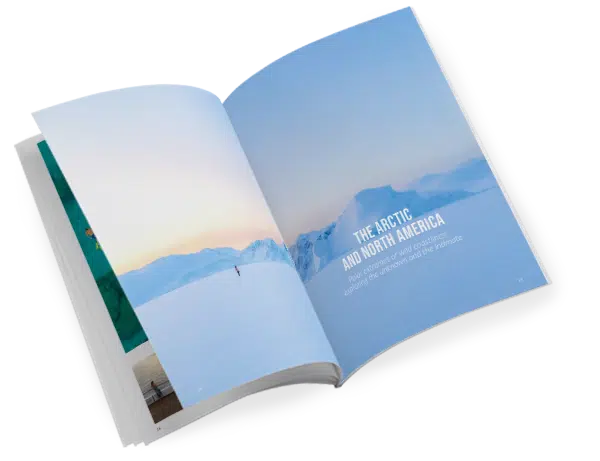The emperor penguin is a unique sea bird. While other animal species leave Antarctica during the winter, and other birds breed in the spring or at the beginning of the austral summer, the emperor penguin is the only animal species to breed in the middle of Antarctica’s austral winter. Discover how this species has adapted to survive remarkably well in these extreme conditions.
The Emperor on the ice
The emperor penguin is the only animal species to spend the whole year in Antarctica. It also reproduces in the middle of winter, when the weather conditions are the harshest. Another remarkable feat. But this strategic choice allows the young penguins to break away from their parents at the beginning of the summer, when food is abundant.
Its reproductive cycle lasts a great deal of the year since it runs from March to December. After spending two months at sea stockpiling food, the adult emperor penguins arrive on the ice at the beginning of winter, when the sea ice starts creating ice jams. At the same time, other animals leave Antarctica in the search for more lenient weather conditions.

After walking sometimes over a hundred kilometres on the sea ice, in columns hundreds of individuals strong, the emperor penguins make their way back to the colony, often made up of tens of thousands of birds. There are around sixty colonies of emperor penguins in Antarctica.
The couples then get together and the female lays a single egg between May and June. Once they have laid their egg, the breeding females leave the colony to go back to the sea to feed, leaving the male alone to incubate the egg. The male incubates the egg by keeping it on its feet, well-hidden under a fold of skin. This is a particularly crucial operation because, if the egg were to stay on the ice for too long, it would freeze almost instantly.

The eggs hatch in July. The females then make their return to the colony and feed their chick by regurgitating the contents of their stomach. They can feed the chick that way for around a month. During that period, it is the turn of the males, who have fasted for over four months and lost up to 45% of their initial mass, to take the silent road to the open water which lies several kilometres away. They can then hunt, stock up on food, and come back to the colony to feed their young.
The breeding females and males, these indefatigable walkers, must travel several times between the colony and ice-free zones before the young become self-sufficient, in December when the ice breaks up.
This breeding period during the austral winter makes the emperor penguin one of the warm-blooded animals to face some of the harshest weather conditions on the planet. How does it survive in such extreme conditions?
The undisputed champion of polar survival
This bird is the only animal in the whole world able to thrive in such a harsh environment. Its anatomy and behaviour is perfectly suited to surviving on the ice.
From an anatomical point of view, the emperor is equipped with many a tool to face the cold. It has four layers of feathers shaped like scales, a thick layer of blubber and a blood system that provides exceptional thermal insulation.

But it also managed to adapt its behaviour in order to survive. Emperor penguins have evolved to stand in such a way as to limit the amount of body surface area exposed to the cold. They rest on their claws and on a layer of blubber under their feet, retract their necks and turn their backs to the wind.
Furthermore, they are pacifists and one of the few bird species to not be territorial. This special feature and the fact they do not build nests, instead covering their egg on their feet, allow them to be constantly on the move within the colony. That way, they can engage in thermoregulatory behaviour, which is essential to their survival. Indeed, emperor penguins stick together to form very dense groups known as turtle formations with a microclimate inside. This allows individual penguins in the centre to warm up and thus minimise heat loss. They swap places with each other, rotating between the centre and the outside of the formation.
Once they become thermally independent, the chicks also adopt this behaviour. They join up to make nurseries and form chick turtle formations to survive temperatures that can drop below -50°C.
Aptenodytes Forsteri: a swimming and singing prodigy
As well as adapting exceptionally well to the austral winter, this bird has other abilities that make it unique.

For example, each emperor penguin has its own singing style. This voice signature allows members of the same family to recognise and find each other in the middle of a colony made up of tens of thousands of penguins.
Just like all penguins, emperor penguins are flightless birds. However, they are excellent swimmers and are therefore perfectly suited to their environment. Indeed, emperor penguins are spectacular marine predators, capable of diving to depths of up to 500 metres and remaining underwater for up to 30 minutes. They use their wings as fins and their feet and tail as a rudder.
The scientific name of the emperor penguin, Aptenodytes forsteri, is a reference to its abilities as Aptenodytes comes from the Greek words apteron which means “wingless” and dytes which means “diver”.
How to tell an emperor penguin from a royal penguin?
Royal penguins live in a more temperate climate, they can be found in the shores of subantarctic islands. They nest in ice-free areas like beaches with close access to the sea. They are around 90 cm tall, whereas the emperor penguin is 120 cm tall on average. They have a black and orange beak and a black head with a bright orange crest. The chicks have brown fur whilst emperor penguin chicks are light grey with a black head and white markings around the eyes.


PONANT takes you there
Try to approach the Antarctica’s Emperor with Le Commandant Charcot.



